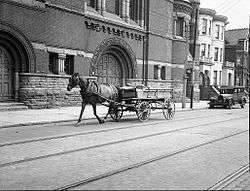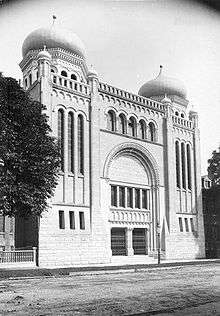History of the Jews in Toronto
| Part of a series on |
| Ethnicity in Toronto |
|---|
|
|
|
|


The History of the Jews in Toronto refers to the history of the Jewish community of Toronto, Ontario. Jews have resided in Toronto since the early 19th century. Since the 1970s, the city has been home to the largest Jewish population in Canada and become a centre of Jewish Canadian culture. Toronto's Jews have played an important role in the development of the city.'
According to the 2001 census, 164,150 Jews lived in Toronto.
History
The earliest record of Jewish settlement in York is an 1817 communication between colonial offices. The report indicated that several weddings had taken place, one of which was Jewish.[1] However, the first permanent Jewish presence in Toronto began in 1832, with the arrival of Arthur Wellington Hart, the Harts being among the most established Jewish families of British North America. By 1846, the census indicated that 12 Jews lived in Toronto, with the number doubling the following year.[2] The first Jewish cemetery was established in 1849 and Toronto's first synagogue, the Toronto Hebrew Congregation, was founded in 1856.[3]

In the late nineteenth and early part of the twentieth century, the Jewish community and other non-British immigrants were densely concentrated in "The Ward" between College Street, Queen Street, Yonge Street and University Avenue.
Mendel Ryman, who immigrated to Toronto from Jezierna, a town in the Austrian Empire, in 1903, built the first Jewish bathhouse and mikvah (shvitz) on Center Avenue.[4]
Toronto's Jews generally centred themselves in distinct neighbourhoods and ethnic enclaves. By the 1930s, the largest concentration of Jews had moved west from "The Ward" to Kensington Market with Jews representing upwards of 80% of the population.[5] Between Queen and Bloor Streets, toward Dovercourt, Jews established a distinct domicile, forming the ethnic majority in many areas. Often, employment opportunities determined the areas in which the Jews settled, as in the case of the Spadina district, a hub of the textile industry.
With the election of the first Parti Québécois government in 1976 and the looming prospect of Quebec independence, many members of Montreal's largely anglophone Jewish community migrated to Toronto. As a result, Canada's epicentre of Jewry effectively moved to Toronto.[6] Simultaneously, Toronto Jews left the crowded confines of the ethnic neighbourhoods within the city's core, retreating to the near suburbs along Bathurst Street.[7]
Demographics
In 1871, 157 Jews lived in Toronto, rising to 1,425 by 1891 and 3,090 by 1901. The community grew in the wake of immigration from Europe, where the Jews suffered from persecution and pogroms. By 1911, the Jewish population of Toronto had grown to 18,237. The number almost doubled by 1921. In 1931, there were 45,000 Jews living in Toronto, mostly Polish Jewish immigrants. After 1924, when the United States imposed immigration restrictions, Toronto attracted a growing number of Jewish immigrants. On the eve of World War II, the Canadian government also cracked down on immigration. As a result, only small groups of Austrian and German Jews fleeing Hitler found a safe haven in Toronto during this period. In 1941, the Jewish population was 49,046,[8] comprising the largest ethnic minority in Toronto.[9]
Religious and cultural institutions
In 1849, Abraham Nordheimer purchased land for a cemetery on behalf of the Toronto Hebrew Congregation, an Orthodox synagogue that became known as the Daytshishe Shul. In 1856, Lewis Samuel of York, England helped to found the Sons of Israel Congregation, which merged with Toronto Hebrew Congregation in 1858. In the 1920s, the synagogue became a Reform synagogue, joining the Union of American Hebrew Congregations.[8] As Jews fleeing the pogroms in Czarist Russia in the 1880s began to settle in Toronto, three new synagogues were established. Goel Tzedek and Beth Hamidrash Hagadol Chevra Tehillim, founded by Russian Jews in 1883, and Shomrei Shabbos, founded in 1888 by Jews from Galicia, Poland.[8] In 1889, two more congregations were established: Beth Jacob, known as the Poylishe Shul, and Adath Israel, founded by Romanian Jews.[8]
For ten years, Shomrei Shabbos was housed in rented buildings along Richmond Street. The first permanent synagogue was on Chestnut Street. A year later, the first rabbi was brought to Toronto, Rabbi Joseph Weinreb of Busk, Galicia. In 1933, the synagogue moved to a larger building that could seat 300 on the corner of Brunswick and Sussex.[10]
In the decades leading up to World War I, the community established Jewish afternoon schools, theatres, a newspaper, and mutual-aid societies.[11]
Neighbourhoods
Bathurst Street has been the heart of the Jewish community of Toronto for many decades.[12] Since the early twentieth century, Jews have lived around Bathurst Street south of Bloor Street east to Spadina Avenue (particularly in the Kensington Market district) and west to beyond Christie Pits. After World War II, wealthier members of the community moved to Forest Hill.[13] Today, much of the Jewish community resides along the street from north of St. Clair Avenue to south of Lawrence Avenue and beyond the city limits at Steeles Avenue, extending to Elgin Mills Road in Richmond Hill.[14] Since the early 1970s, the northern stretch of Bathurst has become one of the centres of the Russian Jewish community in Toronto.[15] The electoral district of York Centre has the largest number of Russo-Canadian voters in Canada. Due to the large number of Russian delicatessens, restaurants, and book and clothing stores, the neighbourhood has been nicknamed "Little Moscow." [16]
Notable residents
See also
References
- ↑ Speisman, Stephen A., The Jews of Toronto: A History to 1937, Toronto: McClelland and Stewart Limited, 1979, p. 11.
- ↑ Speisman, Stephen A., The Jews of Toronto: A History to 1937, Toronto: McClelland and Stewart Limited, 1979, p. 15.
- ↑ Speisman, Stephen A., The Jews of Toronto: A History to 1937, Toronto: McClelland and Stewart Limited, 1979, p.22.
- ↑ Tales of Toronto’s first Jewish shvitz
- ↑ Marks, Lynne, Kale Meydelach or Shulamith Girls: Cultural Change and Continuity among Jewish Parents and Daughters - a Case Study of Toronto's Harbord Collegiate Institute in the 1920s, CWS/CF7, no. 3 (1986): 85-89, 88.
- ↑ Tulchinsky, Gerald, Canada's Jews: A People's Journey, Toronto: University of Toronto Press, 2008, p. 444-445.
- ↑ “,” Toronto. Retrieved on: 2010-04-23.
- 1 2 3 4 Toronto, Ontario
- ↑ Tulchinsky, Gerald, Canada's Jews: A People's Journey, Toronto: University of Toronto Press, 2008, p. 208.
- ↑ A Brief History of Our Shul and Kehilah, Shomrai Shabbos-Chevrah Mishanyos Congregation
- ↑ Toronto's first synagogues
- ↑ On Bathurst, the Spine of Jewish Toronto
- ↑ Stephen A. Speisman. The Jews of Toronto: a history to 1937. 1979.
- ↑ Bathurst Manor - Jewish Toronto
- ↑ Newtonbrook Neighbourhood Profile - Doing Jewish in Toronto
- ↑ North York Times
External links
- Jewish Studies Program, University of Toronto
- Jewish Community Portal, Toronto
- Toronto Jewish Community Directory